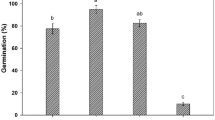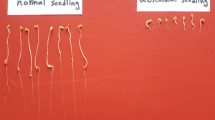Abstract
Environmental conditions can affect seed characteristics in a variety of ways during their development and maturation. This study examined the effects of environmental factors on two aspects of seed quality, namely seed health and seed vigour. The samples were taken from five regions of rice seed production. Seed germination and seedling growth were tested to gauge seed vigour. In order to evaluate seed health, the potato dextrose agar method was used to test for seed-borne fungi contamination. According to the assessment of seed lots, changes in the environment accounted for at least 61% of variation in fungal contamination and at least 74% of variation in germination characteristics. According to stepwise regression and comparative performance analysis, the optimum amounts of minimum temperature (20.56℃), daily sunny hours (8.31), daily precipitation (0.085 mm) and daily relative humidity (79.37%) were required to achieve the best possible values for percent of normal seedling (99.39%), length of seedling (15.14 cm) and percent of germination (99.84%). The gaps between the potential values and seed production under unfavourable environmental conditions were 25.49%, 25.57 mm and 6.8% for normal seedling percentage, length of seedling and germination percentage, respectively. The results of this experiment indicate that low precipitation and relative humidity, as well as an ample supply of sunlight and high altitude in Rostam-Abad, had a significant impact on the fungi in the seeds, which resulted in better seed health and greater seed quality.



Similar content being viewed by others
References
Aghili SR, Shokohi T, Khosravi AR, Salmanian B (2012) Mycoflora contamination of consumed rice in Mazandaran. J Mazand Univ Med Sci 21(86):280–286
Agrawal RL (1995) Seed vigour tests. Seed technology, 2nd edn. Oxford and IBH Pub. Co., New Delhi, pp 583–590
Baskin CC, Baskin JM (2014) Seeds: ecology, biogeography, and evolution of dormancy and germination, 2nd edn. Elsevier, Academic Press, London. https://doi.org/10.1016/C2013-0-00597-X
Chiu MC, Chen CL, Chen CW, Lin HJ (2022) Weather fluctuation can override the effects of integrated nutrient management on fungal disease incidence in the rice fields in Taiwan. Sci Rep 12(1):1–9. https://doi.org/10.1038/s41598-022-08139-7
Cleveland TE, Yu J, Bhatnagar D, Chen ZY, Brown RL, Chang PK, Cary JW (2004) Progress in elucidating the molecular basis of the host plant—Aspergillus flavus interaction, a basis for devising strategies to reduce aflatoxin contamination in crops. J Toxicol Toxin Rev 23(2):345–380. https://doi.org/10.1081/TXR-200027892
Contreras S, Bennett MA, Metzger JD, Tay D (2008) Maternal light environment during seed development affects lettuce seed weight, germinability and storability. Hort Sci 43(3):845–852. https://doi.org/10.21273/HORTSCI.43.3.845
Crusciol CAC, Arf O, Soratto RP, Mateus GP (2008) Grain quality of upland rice cultivars in response to cropping systems in the Brazilian tropical savanna. Sci Agric 65(5):468–473. https://doi.org/10.1590/S0103-90162008000500004
Dash C (2013) Seed health and quality test of three rice varieties for the detection of fungi associated with seed sample. Univers J Plant Sci 1(2):37–42. https://doi.org/10.13189/ujps.2013.010202
Dean R, Van-Kan JA, Pretorius ZA, Hammond-Kosack KE, Di-Pietro A, Spanu PD, Rudd JJ, Dickman M, Kahmann R, Ellis J, Foster GD (2012) The top 10 fungal pathogens in molecular plant pathology. Mol Plant Pathol 13(4):414–430. https://doi.org/10.1111/j.1364-3703.2011.00783
Ellis R, Hong T (1994) Desiccation tolerance and potential longevity of developing seeds of rice (Oryza sativa L.). Ann Bot 73(5):501–506. https://doi.org/10.1006/anbo.1994.1062
Ellis RH (2011) Rice seed quality development and temperature during late development and maturation. Seed Sci Res 21(02):95–101. https://doi.org/10.1017/S0960258510000425
Finch-Savage WE, Bassel GW (2015) Seed vigour and crop establishment: extending performance beyond adaptation. J Exp Bot 67(3):567–591. https://doi.org/10.1093/jxb/erv490
Hampton JG, Tekrony DM (1995) Handbook of vigour test methods. The International Seed Testing Association, Zurich, p 117
Hampton JG, Conner AJ, Boelt B, Chastain TG, Rolston P (2016) Climate change: seed production and options for adaptation. Agriculture 6(3):33. https://doi.org/10.3390/agriculture6030033
He H, de Souza Vidigal D, Snoek LB, Schnabel S, Nijveen H, Hilhorst H, Bentsink L (2014) Interaction between parental environment and genotype affects plant and seed performance in Arabidopsis. J Exp Bot 65(22):6603–6615
Khosravi V, Javan-Nikkhah M, Saremi H, Naeimi S (2019) Evaluation of the pathogenicity of several Fusarium species isolated from rice seed in laboratory and tracing of seeds transmission of rice Bakanae disease. Iran J Plant Pathol 55(3):193–208. https://doi.org/10.22034/ijpp.2019.38321
Li W, Cui J, Li J, Guo J, Huang T, Zhang J, Hu H, Liu X (2022) Analysis of the fungi community variation during rice storage through high throughput sequencing. Processes 10(4):754. https://doi.org/10.3390/pr10040754
Martinez-Eixarch M, Ellis RH (2015) Temporal sensitivities of rice seed development from spikelet fertility to viable mature seed to extreme temperature. Crop Sci 55(1):354–364. https://doi.org/10.2135/cropsci2014.01.0042
Mathur S, Kongsdal O (2003) Common laboratory seed health testing methods for detecting fungi. International Seed Testing Association, Luzern, p 425
McDonald M (1999) Seed deterioration: physiology, repair and assessment. Seed Sci Tech 27(1):177–237
Mew TW, Gonzales P (2002) A handbook of rice seedborne fungi. International Rice Research Institute, Zaragosa, p 83
Mohammed AR, Tarpley L (2010) Effects of high night temperature and spikelet position on yield-related parameters of rice (Oryza sativa L.) plants. Eur J Agron 33(2):117–123
Monajjem S, Zeinali E, Ghaderi-Far F, Soltani E, Hoseyni-Chaleshtari M, Khoshkdaman M (2014) Evaluation seed-born fungi of rice (Oryza sativa L.) and that effect on seed quality. J Plant Pathol Microbiol 5(4):1–7. https://doi.org/10.4172/2157-7471.1000239
Munkvold GP (2009) Seed pathology progress in academia and industry. Annu Rev Phytopathol 47:285–311. https://doi.org/10.1146/annurev-phyto-080508-081916
Mutters RG, Thompson JF (2009) Rice quality handbook. UCANR Publications, California
Nagarajan S, Jagadish S, Prasad AH, Thomar A, Anand A, Pal M, Agarwal P (2010) Local climate affects growth, yield and grain quality of aromatic and non-aromatic rice in northwestern India. Agric Ecosyst Environ 138(3):274–281
Ocumpaugh W, Lloyd-Reilley J, Rasmussen G, Maher S (2008) Environmental influences on seed quality of Windmillgrass ecotypes in South Texas. Agron J 100(4):1205–1210
Oladiran A, Iwu L (1993) Studies on the fungi associated with tomato fruit rots and effects of environment on storage. Mycopathologia 121(3):157–161
Padua GPD, França-Neto JDB, Carvalho MLMD, Krzyzanowski FC, Guimarães RM (2009) Incidence of green soybean seeds as a function of environmental stresses during seed maturation. Rev Bras Sementes 31(3):150–159. https://doi.org/10.1590/S0101-31222009000300017
Pantuwan G, Fukai S, Cooper M, Rajatasereekul S, O’Toole J (2002) Yield response of rice (Oryza sativa L.) genotypes to different types of drought under rainfed lowlands: Part 1. Grain yield and yield components. Field Crops Res 73(2):153–168
Rahman SMA, Ellis RH (2019) Seed quality in rice is most sensitive to drought and high temperature in early seed development. Seed Sci Res 29(4):238–249
Reed RC, Bradford KJ, Khanday I (2022) Seed germination and vigor: ensuring crop sustainability in a changing climate. Heredity 128:450–459. https://doi.org/10.1038/s41437-022-00497-2
Reddy KRN, Reddy CS, Mangala UN, Muralidharan K (2006) Site of infection of Aspergillus sp. in seeds of rice cultivars. J Mycol Plant Pathol 36:271–277
Regasa T, Mekbib F, Eticha F (2015) Effect of production sites and seed age on seed quality parameters of malt barley (Hordium vulgare L.) varieties. Int J Plant Physiol Biochem 7(4):40–45. https://doi.org/10.5897/IJPPB2015.0234
Shahbaz-Farooq M, Gyilbag A, Virk AL, Xu Y (2021) Adaptability mechanisms of Japonica rice based on the comparative temperature conditions of Harbin and Qiqihar Heilongjiang province of northeast China. Agronomy 11(11):2367. https://doi.org/10.3390/agronomy11112367
Siebenmorgen TJ, Grigg BC, Lanning SB (2013) Impacts of preharvest factors during kernel development on rice quality and functionality. Annu Rev Food Sci Technol 4:101–115
Soltani A (2007) Application of SAS in statistical analysis, 2nd edn. JDM Press, Mashhad, p 182
Soltani A, Gholipoor M, Zeinali E (2006) Seed reserve utilization and seedling growth of wheat as affected by drought and salinity. Environ Exp Bot 55(1):195–200
Soltani A, Hajjarpour A, Vadez V (2016) Analysis of chickpea yield gap and water-limited potential yield in Iran. Field Crops Res 185:21–30
Soltani A, Maddah V (2010) Simple applied programs for education and research in agronomy. Iranian Society of Ecological Agriculture, Tehran, p 80
Steadman KJ, Ellery AJ, Chapman R, Moore A, Turner NC (2004) Maturation temperature and rainfall influence seed dormancy characteristics of annual ryegrass (Lolium rigidum). Crop Pasture Sci 55(10):1047–1057
Tanveer A, Tasneem M, Khaliq A, Javaid M, Chaudhry M (2013) Influence of seed size and ecological factors on the germination and emergence of field bindweed (Convolvulus arvensis). Planta Daninha 31(1):39–51
Thitisaksakul M, Jiménez RC, Arias MC, Beckles DM (2012) Effects of environmental factors on cereal starch biosynthesis and composition. J Cereal Sci 56(1):67–80
Uma V, Wesely E (2013) Seed-borne fungi of rice from South Tamil Nadu. J Acad Ind Res 1:612–614
Walters C, Ballesteros D, Vertucci VA (2010) Structural mechanics of seed deterioration: standing the test of time. Plant Sci 179(6):565–573
Wang X, Zheng H, Tang Q, Chen Q, Mo W (2020) Seed filling under different temperatures improves the seed vigor of hybrid rice (Oryza sativa L.) via starch accumulation and structure. Sci Rep 10(1):1–9. https://doi.org/10.1038/s41598-020-57518-5
Wassmann R, Jagadish SV, Sumfleth K, Pathak H, Howell G, Ismail A, Serraj R, Redona E, Singh RK, Heuer S (2009) Regional vulnerability of climate change impacts on Asian rice production and scope for adaptation. Adv Agron 102:91–133. https://doi.org/10.1016/S0065-2113(09)01003-7
Weerasekara I, Sinniah UR, Namasivayam P, Nazli MH, Abdurahman SA, Ghazali MN (2021) The influence of seed production environment on seed development and quality of Soybean (Glycine max (L.) Merrill). Agronomy 11(7):1430. https://doi.org/10.3390/agronomy11071430
Xing ZP, Pei WU, Ming ZH, Qian HJ, Hu YJ, Guo BW, Wei HY, Ke XU, Huo ZY, Dai QG, Zhang HC (2017) Temperature and solar radiation utilization of rice for yield formation with different mechanized planting methods in the lower reaches of the Yangtze River. China J Integr Agric 16(9):1923–1935. https://doi.org/10.1016/S2095-3119(16)61596-4
Yu X, Tao X, Liao J, Liu S, Xu L, Yuan S, Zhang Z, Wang F, Deng N, Huang J, Peng S (2022) Predicting potential cultivation region and paddy area for Ratoon rice production in China using Maxent model. Field Crops Res 275:108372. https://doi.org/10.1016/j.fcr.2021.108372
Zhu SY, Hong DL, Jin Y, Tian-Kuan L (2008) Comparison between two hybrid cultivars of indica rice (Oryza sativa L.) in seed vigor and biochemical traits after aging. Chin J Eco Agric 16(2):396–400. https://doi.org/10.3724/SP.J.1011.2008.00396
Acknowledgements
The current research has been supported by Guilan Science & Technology Park (GSTP) of Iran, university of Guilan and Sabz Fanavaran Loozan Shomal Co. We would like to thank them.
Funding
Open access funding enabled and organized by Project DEAL.
Author information
Authors and Affiliations
Corresponding author
Ethics declarations
Conflict of interest
The authors have no relevant financial or non-financial interests to disclose.
Additional information
Communicated by V. Mohler.
Rights and permissions
Springer Nature or its licensor holds exclusive rights to this article under a publishing agreement with the author(s) or other rightsholder(s); author self-archiving of the accepted manuscript version of this article is solely governed by the terms of such publishing agreement and applicable law.
About this article
Cite this article
Monajjem, S., Soltani, E. A quantitative analysis to find important determinant environmental factors on seed quality of upland rice (Oryza sativa L.). CEREAL RESEARCH COMMUNICATIONS 51, 483–493 (2023). https://doi.org/10.1007/s42976-022-00303-z
Received:
Accepted:
Published:
Issue Date:
DOI: https://doi.org/10.1007/s42976-022-00303-z




